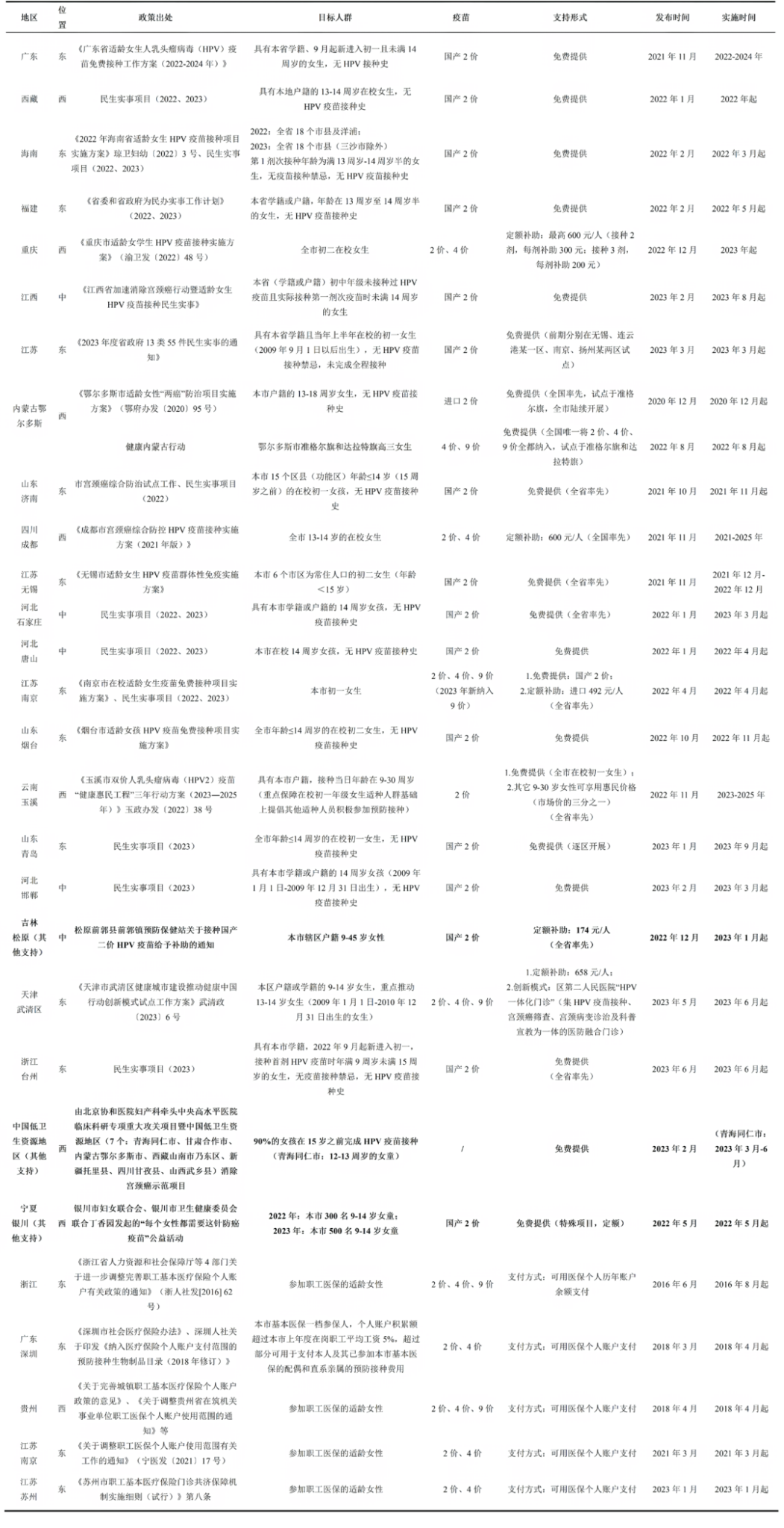Journal Content Recommandation
01
Financing the introduction of new vaccines to the national immunisation programme in China: challenges and options for action
This article, published in BMJ Global Health by Xinyu Zhang, Shu Chen, Kun Zhu, and Shenglan Tang, provides a comprehensive analysis of the current financing landscape, key challenges, and policy recommendations for introducing new vaccines into China’s National Immunisation Programme (NIP). As a typical middle-income country ineligible for external support, China has not introduced any new vaccines WHO-recommended into its NIP since 2008 due largely to financial constraints.
First, fluctuating and insufficient public funding: NIP financing relies solely on government allocations, which have been declining along with the shrinking birth cohort, undermining the introduction and widespread adoption of new vaccines. Second, limited financing channels: current regulations prohibit the use of social health insurance funds for immunisation services, resulting in inefficient resource allocation. Third, affordability barriers: non-NIP vaccines are often expensive and lack public subsidies, diminishing vaccine uptake. Fourth, a complex and opaque decision-making process: the inclusion of new vaccines into the NIP is delayed by non-transparent procedures and limited stakeholder engagement. Despite these challenges, the study highlights three key opportunities: increasing political commitment at the national level to expand NIP coverage; growing local government initiatives to provide free or subsidised vaccines; and declining prices of domestically-produced vaccines due to market competition and improved procurement strategies.
To address these issues, the study proposes the following recommendations: (1) increase government funding at both central and local levels to ensure long-term sustainability; (2) diversify financing mechanisms by exploring the partial use of health insurance funds to cover immunisation services; (3) improve procurement strategies through value-based centralised procurement and price negotiation to reduce vaccine costs; and (4) streamline the NIP decision-making process by establishing a transparent and evidence-based framework for vaccine introduction. This study also offers valuable insights for other middle-income countries seeking to strengthen the financial sustainability of their national immunisation programmes.
https://doi.org/10.1136/bmjgh-2024-017970
02
Global estimates of rotavirus vaccine efficacy and effectiveness: a rapid review and meta-regression analysis
This study, published in eClinical Medicine,conducted a systematic review and meta-regression analysis to examine global variations in the efficacy and effectiveness of rotavirus vaccines. Using a rapid review approach covering studies published between July 2020 and October 2024, the researchers searched PubMed, EMBASE, Cochrane, and Web of Science, ultimately including 100 eligible clinical trials and real-world evidence. A meta-regression model was then developed based on 10 country-level accessibility predictors, including diarrhoea prevalence among children under five, under-five mortality rate, coverage of sanitation facilities, among others.
Results revealed significant regional disparities in predicted vaccine efficacy (VE): Predicted VE ranged from 69.6% to 94.3% in countries across the Americas, Europe, and the Western Pacific Region, while lower VE estimates ranging from 18.6% to 85.3% were observed in the African, South-East Asian, and Eastern Mediterranean regions. Moreover, the study found a nonlinear relationship between vaccine efficacy and vaccine effectiveness (VEff): Estimates of vaccine effectiveness were generally lower than vaccine efficacy when efficacy exceeded 60%, but effectiveness was predicted to be higher when vaccine efficacy was low. Model validation further demonstrated strong predictive performance:A strong correlation (r = 0.63) was observed between the predicted and observed values of VE and VEff, and 98.2% of observed estimates fell within the 95% prediction intervals.
The predictive model developed in this study highlights the global heterogeneity in rotavirus vaccine performance, offering evidence to support benefit-risk assessments in countries that have not yet introduced rotavirus vaccines. However, improvements are needed in the quality of predictor data—for example, standardized diarrhoea surveillance—and broader geographic representation of clinical trials, particularly in high-burden regions such as Africa, to enhance the robustness of the estimates.
https://doi.org/10.1016/j.eclinm.2025.103122
03
Outbreak report of rotavirus gastroenteritis among remotely vaccinated travelers: A potential implication of booster vaccine for travelers to endemic countries
This study published in Human Vaccines & Immunotherapeutics, retrospectively reported an outbreak of rotavirus gastroenteritis among a group of Japanese travelers (14 children and 9 adults) who spent four weeks in Malaysia. The study also explored the potential need for booster vaccination among travelers to endemic areas, providing important insights for evaluating the long-term protection of rotavirus vaccines.
During the trip, 15 of the 23 individuals developed symptoms of gastroenteritis. Stool samples collected from two symptomatic patients tested positive for rotavirus. Comparative analysis revealed three key findings: (1) None of the five individuals with a prior history of rotavirus infection developed symptoms, suggesting that natural infection may confer long-lasting immune protection; (2) Among the ten children vaccinated during infancy, nine developed mild symptoms of acute gastroenteritis, though none required hospitalization, indicating waning vaccine protection over time; (3) The only unvaccinated child with no history of prior infection developed severe symptoms and required hospitalization, underscoring the importance of primary immunization.
The study suggests that a prior rotavirus infection may offer more durable protection than vaccination during infancy, and that vaccine-derived immunity may diminish over time. These findings support the potential benefit of administering booster doses to travelers heading to regions where rotavirus is endemic—particularly for individuals without prior infection or whose last vaccination occurred years ago. Future research should further assess the clinical benefit of booster doses in such populations, to inform immunization strategies for travelers.
https://doi.org/10.1080/21645515.2025.2467475
04
Assessing the Feasibility of Drone-Mediated Vaccine Delivery: An Exploratory Study
This study, published in Health Science Reports, aimed to assess the practicality of the unmanned aerial systems (UASs) for vaccine delivery in remote areas to address logistical challenges. This exploratory study was conducted after obtaining several regulatory approvals and involved five drone missions within the premises of the Indian Institute of Technology (IIT) Kanpur, India. The missions were carried out on a confined airstrip of 3 km², using a multi-rotor, top-load UAS to transport simulated vaccine vials under normal daylight weather conditions. The dummy COVID-19 vaccine vials were packed with cool packs to maintain the required temperature.
The drones demonstrated a maximum flight endurance of 31 minutes while carrying a payload of up to 4.5 Kg, covering an aerial distance of 17 km at an average speed ranging at 12 meters per second. Notably, the vaccine carrier box was able to maintain a recommended temperature of 3°C–4°C throughout the transportation process, and there is no impact of vibration on the physical integrity and leakage of the vaccine vials during flight. The study validated the technical feasibility of using drones for vaccine delivery through empirical testing, offering an efficient and flexible distribution solution for geographically inaccessible areas, particularly for emergency immunization programs.
While this study was conducted under controlled conditions, practical implementation and wider deployment may face challenges such as complex regulatory approvals and the lack of cost-effectiveness analyses. Future efforts should focus on improving drone performance parameters, conducting real-world environmental validations, and refining regulatory frameworks to facilitate large-scale application in public health. These improvements are critical to establishing a more flexible and efficient vaccine distribution system, particularly for responding to public health emergencies and enhancing the accessibility of immunization services in remote areas.
https://doi.org/10.1002/hsr2.70208
05
Future immunisation strategies to prevent Streptococcus pneumoniae infections in children and adults
This study, published in The Lancet Infectious Diseases, systematically reviewed clinical data (immunogenicity and safety) and epidemiological evidence on pneumococcal vaccines globally from 2000 to 2024, and proposed three strategic directions for future immunisation policies.
First, expanding serotype coverage in conjugate vaccines is a key priority. PCV15 and PCV20 have been approved for use in both children and adults, adding coverage for highly pathogenic serotypes such as 8 and 12F. Evidence shows that in adults, PCV20 elicits stronger antibody responses against the seven additional serotypes compared to PCV13. However, increased valency may lead to antigenic interference, highlighting the need to optimize the polysaccharide-to-protein ratio in vaccine formulations.
Second, enhancing pneumococcal vaccination strategies in adults is crucial. Currently, adult protection largely relies on indirect effects of childhood immunisation, which are undermined by serotype replacement—particularly serotypes such as 3 and 22F. It is recommended that adults aged 65 years and older, as well as high-risk populations, receive higher-valent pneumococcal vaccines to reduce the incidence of invasive pneumococcal disease (IPD) and non-bacteraemic pneumococcal pneumonia (NBPP).
Third, the development of pneumococcal protein-based vaccines should be accelerated. Multivalent vaccines based on conserved pneumococcal proteins—such as Ply and PcpA—can potentially overcome the limitations of serotype-specific protection and offer more durable immunity. Early-phase clinical trials have demonstrated good safety profiles for trivalent protein vaccines (e.g., PhtD-Ply-PcpA) in infants and young children. However, their limited efficacy in reducing nasopharyngeal colonisation indicates the need for improved antigen combinations and the establishment of mucosal immunity evaluation frameworks.
The study emphasises that future strategies must address challenges such as serotype replacement and immune evasion. This includes developing standardised immunological correlates of protection to support vaccine development and ultimately reduce the global burden of pneumococcal disease.
https://doi.org/10.1016/S1473-3099(24)00740-0
06
Impact of 10-valent pneumococcal conjugate vaccine on the epidemiology of otitis media with otorrhea among Bangladeshi children
This study was published in Vaccine,evaluates the impact of the ten-valent pneumococcal conjugate vaccine (PCV10) on pneumococcal otitis media (OM), a prevalent OM among children in low-and-middle income countries, including Bangladesh. In 2015, Bangladesh introduced the ten-valent pneumococcal conjugate vaccine (PCV10). The study analyzed ear swabs from OM cases with otorrhea, collected at the largest pediatric hospital in Dhaka, Bangladesh from April 2014 to March 2019.
The results showed that four years after PCV10 introduction, the rate of detection of pneumococcus among otorrhea cases decreased from 18.4 % (164/892) in 2014–15 to 15.6 % (581/3735) in 2018–19, reflecting a 15.4 % reduction. Notably, vaccine serotypes (VTs) demonstrated a significant decline throughout the post-PCV years, with a 44.1 % reduction compared to the pre-PCV period. Specific VTs like 14, 6B and 19F exhibited significant reductions of 60.2 %, 57.5 % and 42.9 % respectively. Conversely, non-vaccine serotypes (NVTs) showed non-significant increase of 8.6 %; specifically serotype 35B showed a 70.1 % increase. Administration of two or three doses of PCV10 provided 84.4 % protection against OM cases caused by serotypes covered by PCV10.
The study indicates that while PCV10 is effective in preventing otitis media with otorrhea caused by vaccine-included serotypes, the phenomenon of serotype replacement limits its overall impact on disease burden. The authors recommend that continued pathogen surveillance be used to guide vaccine strategy optimization, and in regions where significant serotype epidemiological shifts are observed, the introduction of higher-valency vaccines with broader coverage should be considered.
https://doi.org/10.1016/j.vaccine.2025.126995
Policy Briefs
WHO Publishes Updated Position Paper on Mumps Virus Vaccines
In March 2024, the World Health Organization (WHO) released an updated position paper on mumps virus vaccines, providing substantial revisions to the 2007 version based on recent advancements in global epidemiological and vaccinological research. The paper highlights that in countries implementing measles-mumps-rubella (MMR) vaccination, the incidence of mumps has decreased significantly—from 100–1000 cases per 100,000 population to fewer than 1 case per 100,000. However, when childhood vaccination coverage falls below 80%, mumps may resurge in adolescents and adults, leading to a higher risk of complications.
As of 2023, 63% of WHO Member States (123 out of 194) have incorporated mumps vaccines into their National Immunization Programmes (NIPs), predominantly using MMR or measles-mumps-rubella-varicella (MMRV) combination vaccines. WHO-prequalified vaccine strains, such as Jeryl–Lynn and RIT 4385, have well-established efficacy. However, other strains used in certain countries—such as Hoshino and Torii—require additional clinical data to validate their performance.
Evidence supports that a two-dose vaccination schedule provides long-term immune protection and significantly reduces the risk of complications such as orchitis, oophoritis, and meningitis. However, waning immunity over time has been observed, particularly in settings where coverage does not meet herd immunity thresholds, thereby increasing infection risk among adults.
WHO emphasizes that national vaccination strategies should aim for and maintain at least 80% coverage, prioritizing the use of combination vaccines containing the mumps component. Moreover, global surveillance systems must be strengthened to improve data quality on mumps epidemiology and vaccine performance, thereby enabling timely policy adaptation based on robust scientific evidence.
https://www.who.int/publications/i/item/who-wer-9911-115-133
Content Editor: Ziqi Liu
Page Editor: Ziqi Liu





